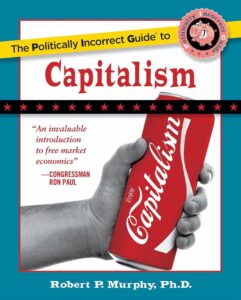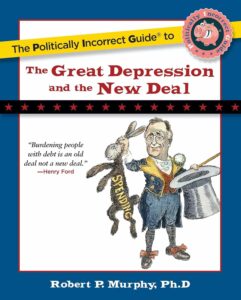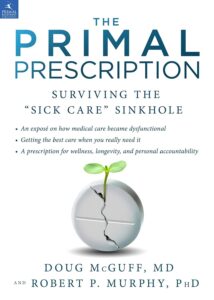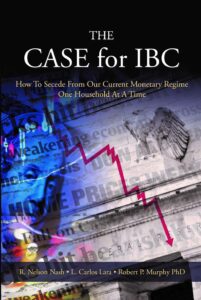A Picture Is Worth a Thousand Lies
This is hilarious. Lew Rockwell sends along the Cleveland Fed’s latest video in its, “Really bad drawings, real simple explanation” series (check the link if you think I’m making up the title). It’s 9 minutes long so maybe that’s too much for you, but at least watch it through 3:55 to see the graph of how the Fed maintains a stable purchasing power of the dollar from 1 – 10 years out.
If someone has a lot of free time on his or her hands, it would be hilarious to do a parody of this, explaining how the CIA works.
In closing, I must say that the tone of this video intrigues me. You get the sense that the actual Fed staffers know full well they’re participating in something shady. For example listen in the beginning when they introduce Ben Bernanke, or at the very end when they say, “However you feel about the Fed…”
Bernanke Still Breaking Records
Reports of the imminent collapse of the monetary base have thus far been greatly exaggerated… I’m not saying that Bernanke was lying when he claimed the base would start shrinking real soon, I just want to point out that it wouldn’t be the first time.
This Is Potentially the Screwiest GDP Chart I’ve Ever Seen
Paul Krugman links to Mark Thoma who in turn cribs from the Federal Reserve Bank of San Fran to give us…

The definition of “potential GDP” comes from the San Fran bank:
Potential output is not a measure of maximum output that can be achieved, but instead maximum sustainable output. As such, it is the level of real GDP that is consistent with stable inflation. When actual real GDP is running higher than potential GDP, the economy is said to be producing above full capacity.
Now look back at that chart, to see if we like the implications of this typical macro way of looking at things. Actual GDP was higher than potential GDP during the recession of 2000-2001; isn’t that a bit weird?
Then, at no time whatsoever during the housing and stock market boom (except maybe a little blip in 2006) was actual GDP higher than potential. According to the CBO’s calculation (which is where SF got the potential GDP number), the US economy in the year, say, 2005 was in a perfectly sustainable configuration. We could have repeated the experience of 2005 indefinitely, if only we had implemented the proper policies.
And now, of course, there is no reason for output to have fallen in the current recession. It’s just that aww shucks aggregate demand collapsed for some nonsensical reason, and now we’re stuck with a trillion dollars less in output per year than we ought to be enjoying.
There are two lessons from all this:
(1) Mainstream macroeconomists have a very very crude notion of the structure of production. Their models literally cannot handle the possibility that an unsustainable boom from 2002-2006 could have physically necessitated a drop in measured output from 2007-2008.
(2) As the persistent von Pepe keeps reminding me, the mainstream focus on CPI as the measure of “inflation” is wrong. As the chart above shows, people who think the economy is in great shape so long as CPI grows at a moderate pace can often fall flat on their faces.
The Futility of a Violent Revolution
I want to give a quick summary of my views on violent resistance to a tyrannical government, in light of the Austin plane attack and the (possible) attack on a Utah IRS facility.
* There is a big difference between arming yourself and saying, “If they come onto my property, it’s show time” versus, “I am going to fly my plane into a government office.” If you’re trying to win converts, the former is a lot more likely to garner sympathy than the latter.
* Proponents of violent resistance have in mind the idea that if we could just get x million fellow citizens to think like us and stand up to Big Brother, we’d eventually win after they killed y million of us. Well OK, but if we had x million fellow citizens who thought like us, then I submit it wouldn’t take violence. They could just stop paying taxes and see what happened. The results would be the same–eventual crumbling of the empire–but with a lot less bloodshed.
* People (like the Austin pilot) who think it’s smart strategy to provoke the government into doing something awful because then the people will rise up, are being awfully optimistic about the mass of Americans they otherwise refer to as “the sheeple.” Remember Waco? How much more awful would the government have to be? But did the average American go buy a long gun and renew his membership in the John Birch society? Of course not. Most Americans just needed to hear a TV anchor give the official explanation. “Oh OK, yeah I guess that makes sense. If I were in charge of rescuing a bunch of children from abusive parents, I’d probably send in chemical weapons and tanks too. Too bad those kids had religious nutjob parents and got burned up.”
Last point:
* People often invoke the Founding Fathers. Yes they were brave and they fought a war to free the country. And yet, many of the same people who love the Founding Fathers go on to chastise present-day Americans by saying, “Our nation of wimps now have a level of taxation far higher than the colonists endured under King George.” Hmm there are two ways to interpret this. One is to say, “It’s time for another bloodletting!” Another is to say, “Hmm maybe the violent American Revolution wasn’t such a hot idea after all.”
Bloomberg Writer Blasts British Keynesianism
This is a pretty uppity article by Matthew Lynn on Bloomberg (HT2 Jeff Tucker):
The U.K. has been in Keynes overdrive for the past 18 months. The budget deficit is already more than 12 percent of gross domestic product, on a par with Greece. And while the Greeks are cutting spending, the British deficit is widening. Figures for January showed another fiscal blowout. At the same time, interest rates have been slashed to 0.5 percent. And the pound has slumped in value, which is supposed to boost demand for British goods, and help close the trade gap.
Just about everything possible has been done to encourage consumption. The results have been miserable.
Retail sales excluding gasoline in January fell 1.2 percent from the previous month, twice as much as economists forecast. The number of people receiving unemployment benefits jumped to 1.64 million in January, the highest level since April 1997. The yield on U.K. government debt is now higher than on Spanish or Italian bonds, a sure sign that investors are losing faith in the country’s ability to pay its debts. The inflation rate has also accelerated to 3.5 percent.
Triple Whammy
In reality, Britain has the worst of all possible worlds: a stagnant economy, a crippling budget deficit and rising prices.
The Keynesian consensus is that things would have been far worse without the stimulus provided by government. And if the economy isn’t pumped up with inflated demand, it will collapse back into recession. If it’s not working, that just proves the stimulus should be even larger.
It is the argument quacks always push: If the medicine isn’t working, increase the dosage.
JFK, Blown Away, What Else Do I Have to Say?
Viresh Amin sends this very interesting snippet. Does anyone know what the official response to this is?
Incidentally, I did a decent amount of research over the summer and concluded that there was more than one shooter. I’m not saying I have a theory as to who shot JFK, just that I am confident the official story is bogus.
I will write up my case at some point, but it will take a lot of my time. I have to get someone to take a diagram from a book and translate it into a computer shot, etc.
Hazmat Team Called to IRS Building in Utah
Details are still sketchy, but apparently two people were carried out on stretchers from an IRS facility and a Hazmat team was called in.
If this turns out to be another attack, let me reiterate my position: This is foolish. Ask yourself this: Why does it even make sense for the government to engage in “false flag” operations (whether or not you think it actually does this)? Because this allows the government to expand its power over a terrified citizenry.
I grant you, average people are less scared from attacks on the IRS as opposed to, say, the subway. But violence is the government’s game. I strongly disagree with the strategy–let alone the morality–of those who think it’s time to fight the US government.
Inventories Don’t Kill Growth–People Kill Growth
[UPDATE below.]
This is an esoteric piece, but is actually one of my personal favorites. I was struggling with this notion of an “inventory bump” in GDP growth for a while, and I resolved the issues (at least to my own satisfaction) in this article. So if you have always been vaguely uncomfortable with people attributing percentages of GDP growth to inventory adjustments, this one’s for you. From the conclusion:
The textbook GDP equation is not false; it is a tautology and so of course it is true. Nonetheless, it is a destructive framework for thinking about macroeconomic events. Abuse of the equation leads economists and pundits to blame savings and praise reckless consumption, to hate imports and love exports, and (in principle) to attribute a doubling in the flow of goods coming out of factories to a nonchange in the level of a nonexistent stock of inventory.
The part I’ve just underlined is the contribution of the article; I came up with an easy numerical illustration showing that the standard GDP logic leads to that absurd possibility.
UPDATE: David R. Henderson has a good piece on “GDP fetishism” at EconLib today. Something isn’t quite clicking for me in his example of the government paying $10 billion to workers who dig holes and then fill them up. David argues that if the workers get paid $10/hour for work that they would only have been willing to do for at least $6, then only $4 billion of “well-being” has been created on net, once we take into account the loss of leisure. But isn’t this too an overstatement, since the workers only value the wages because of the actual goods and services they will be able to buy (and hence redistribute away from everyone else)? Maybe David is capturing that in his categories of price inflation or future tax hikes. Anyway, it’s a good article.







Recent Comments